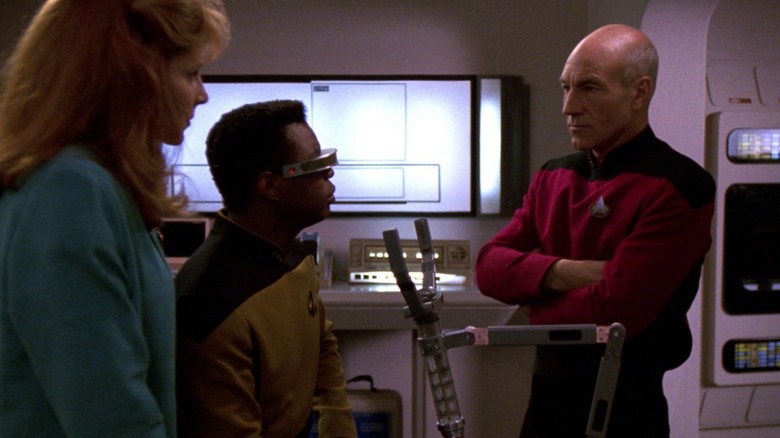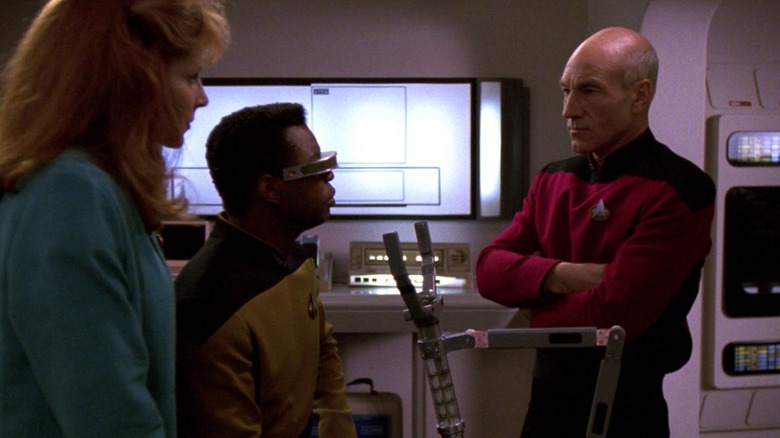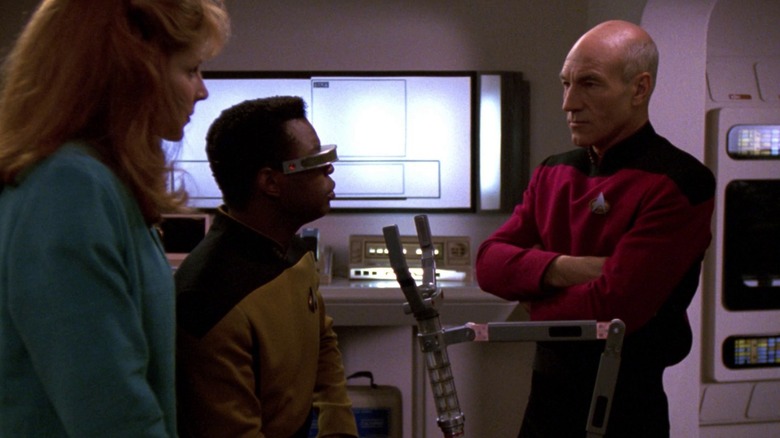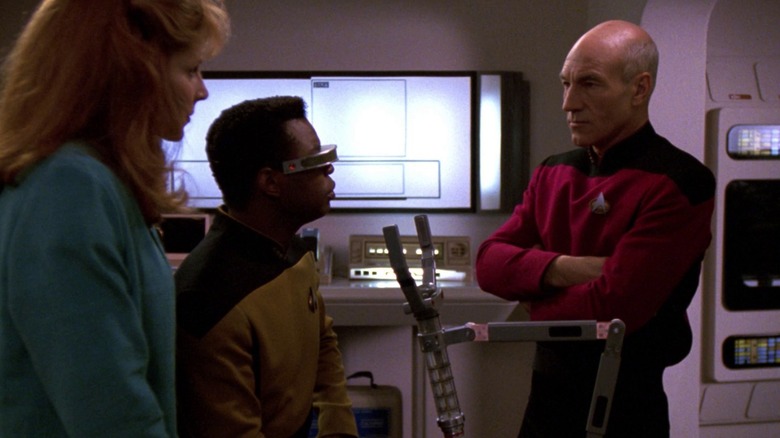Star Trek's Cause And Effect Episode Had TV Stations Flooded With Confused Calls
At the beginning of the 1992 "Star Trek: The Next Generation" episode "Cause and Effect," the U.S.S. Enterprise-D is going about its daily business. The senior staff is enjoying a poker game when the ship encounters a bizarre colossal negative space wedgie. Unexpectedly, a Soyuz-class starship appears out of the wedgie and crashes into the Enterprise, blowing it up. Everyone on board the Enterprise dies.
Then there's a hard reset. The Enterprise staff is mysteriously back at the first scene, playing poker on board a restored starship. They have no memory of being exploded. The day proceeds as it did the first time, only this time some crew members encounter strange aural phenomenon echoing through the ship. Also, everyone seems to have an uncanny sense of déjà vu. After cruising along for a day, the Enterprise encounters the same negative space wedgie as before. Once again, a Soyuz-class starship exits the wedgie, crashes into the Enterprise, and everyone dies again. Then there's another hard reset. Back to the poker game.
The Enterprise, Trekkies may quickly intuit, is trapped in a time loop (called a temporal causality loop in dialogue). Thanks to those aural clues, the Enterprise staff is able to vaguely intuit that something is amiss, but it will take a lot of clever problem-solving to escape the time crisis.
As one might imagine, the constant resetting of the episode back to the same opening poker game caused a little confusion among viewers. "Cause and Effect" was written by Brannon Braga, and he recalled — in a 2022 interview with SyFy — that audiences were calling into TV studios wondering if there was a technical problem that started the episode to restart midway through. No, there was no error. Braga was merely being clever.
Cause and Effect
At the beginning of the "Star Trek: The Next Generation" episode "Cause and Effect" (March 23, 1992), the U.S.S. Enterprise-D is going about its daily business. The senior staff is enjoying a poker game when the ship encounters a bizarre colossal negative space wedgie. Unexpectedly, a Soyuz-class starship appears out of the wedgie and crashes into the Enterprise, blowing it up. Everyone on board the Enterprise dies.
Then there's a hard reset. The Enterprise staff is mysteriously back at the first scene, playing poker on board a restored starship. They have no memory of being exploded. The day proceeds as it did the first time, only this time some crew members encounter strange aural phenomenon echoing through the ship. Also, everyone seems to have an uncanny sense of déjà vu. After cruising along for a day, the Enterprise encounters the same negative space wedgie as before. Once again, a Soyuz-class starship exits the wedgie, crashes into the Enterprise, and everyone dies again. Then there's another hard reset. Back to the poker game.
The Enterprise, Trekkies may quickly intuit, is trapped in a time loop (called a temporal causality loop in dialogue). Thanks to those aural clues, the Enterprise staff is able to vaguely intuit that something is amiss, but it will take a lot of clever problem-solving to escape the time crisis.
As one might imagine, the constant resetting of the episode back to the same opening poker game caused a little confusion among viewers. "Cause and Effect" was written by Brannon Braga and he recalls — in a 2022 interview with SyFy — that audiences were calling into TV studios wondering if there was a technical problem that started the episode to restart midway through. No, there was no error. Braga was merely being clever.
Me too.
Cause & Effect
With those shenanigans out of the way, on with the article.
Braga recalled when he began to share his script that most readers were also very much confused. The episode restarts so abruptly, that a reader/viewer would be deliberately left a little disoriented for a moment. Even Jonathan Frakes, who played Commander Riker on "Next Generation" and who would direct the episode, felt like Braga was messing with him. Frakes would have to find a way to film the same scene multiple times but alter the visuals slightly each time to indicate that something had changed.
Braga recalled the widespread confusion, saying:
"I think people, the reactions to the script were similar to the reactions that the audience had, which was confusion. Because when you're reading that script, you're like: 'Wait. This has to be a mistake.' And this was back when people would call into TV stations, I guess, they would call a lot of affiliates. The show was syndicated, as you know, and the affiliates were getting phone calls during the broadcast [saying] something was wrong with the broadcast."
The interviewer, Phil Pirrello, admitted that he and his father watched the episode during its initial run in 1992, and did indeed call the local TV station — he lived in Erie, Pennsylvania and watched the episode at 11:30 p.m. — to check to see if there had been any technical difficulties. Braga seemed impressed that he hoodwinked so many people. Although he admitted that the confusion was certainly a clue as to the extent to which his episode had failed.
Cause 'n' Effect
Braga said of Pirrello's quizzical call to his local CBS affiliate:
"[T]hat's amazing. I think people bought it once they got past the confusion and probably thought what I did, which is: 'This could be really cool, or it could be an utter and complete failure, right?' It was just not something that was done at the time. The stories [on 'Next Generation'] were linear, and this was something — at the time, anyway — that was fairly radical. But it was a science fiction show, and I thought, 'Well, why can't we do this?' You know, we should experiment more. And if it fails, it fails. We had 26 episodes a season."
One of the advantages of having prolonged seasons in the 1990s was the ability to stretch. On average, the modern TV season runs only 10 episodes, maybe 13. "Star Trek" traditionally ran double that length, permitting for a wide variety of episodes. There were sci-fi stories like "Cause and Effect," but also horror episodes, romances, character-forward shows, political thrillers, and even some straight-up comedy episodes. "Next Generation" did in one season what modern Trek shows do in three.
Brannon Braga, Trekkies may recall, was the most daring of the show's regular writers. When his name appeared in the credits, odds were good that you'd get something a little more cerebral and esoteric. "Cause and Effect," for its arch, repeated construction, could be considered one of the best episodes of the series, replete with a dark mystery, a lot of technobabble, and a conclusion that is utterly satisfying. Be sure to keep an eye out for the Kelsey Grammer cameo.



